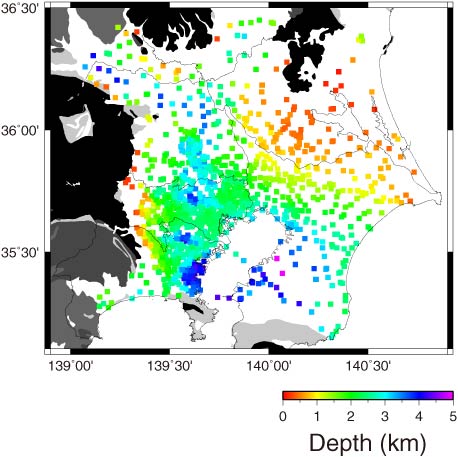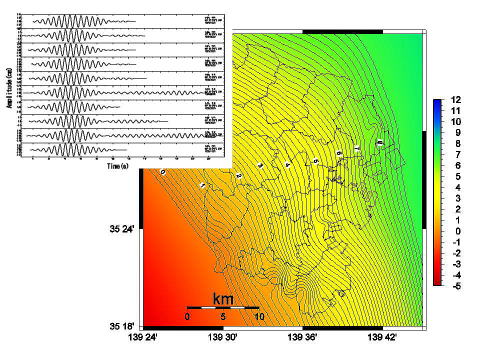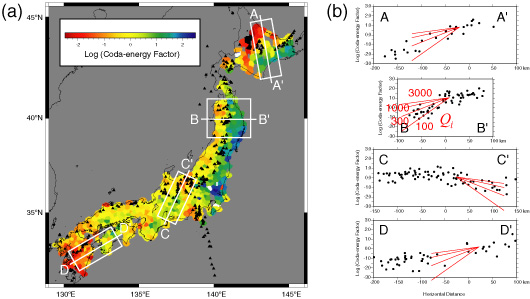Estimation of Seimic Basement Depth in the Metropolitan Tokyo Area
We investigated the seismic basement structure beneath the Metropolitan Tokyo area by the seismic interferometry of strong motion records. High spatial density of the seismic observation stations in the Metropolitan Tokyo area enables us to investigate the local variation of seimic basement depth in this area. About 30,000 acceleration waveforms with high signal-to-noise ratio from local events were used in this analysis.
Our result shows that the seismic interferometry for the seismic waveforms of local earthquakes is quite effective for investigating the local variation of seismic basement depth even in the densely populated area with high ground noise.

Figure.1 Depth of the seismic basement beneath the Metropolitan Tokyo area.
A Graduation Research: Rayleigh Wave Propagation in Yokohama City
We estimated propagation directions and phase velocities of Rayleigh waves in Yokohama city from seismograms of 150 strong ground motion seismometers. Our results show that the propagation directions (paths) of Rayleigh waves are disturbed by the lateral variation of sedimentary structure (seismic basement depth) beneath Yokohama city.

Figure.2 Propagation of a Rayleigh wave packet (period of 6 s) in Yokohama city estimated for a shallow seismic event near Miyake island (after Atarashi, 2006). Examples of band-pass filtered vertical displacement seismograms (above left). Isocontour map showing travel time (unit: s) of observed Rayleigh wave packet (below right).
Research on Spatial Distribution of Seismic Wave Energy
S-coda waves of local earthquakes have been considered as the multiple scattered waves that distribute uniformly in space at large lapse times. However, this concept is only plausible for the seismic scattering in the tectonically stable regions. How does S-coda-wave energy distribute in the tectonically very active regions?
We obtained the following results from the analysis of the seismograms from 18 local earthquakes recorded by the Hi-net that consists of about 700 borehole seismometers in Japan: 1. S-coda-wave energy distributes nonuniformly in space in Japan. Nonuniformness is clear especially in high-frequencies (> 10 Hz); 2. S-coda-wave energy is small in the regions where Quaternary volcanoes exist and high thermal gradient (heat flux) is observed; 3. Nonuniform spatial distribution of S-coda-wave energy may be characterized by the regional variation of intrinsic absorption (or temperature of the lithosphere).

Figure.3 (a) Regional variation of S-coda-wave energy in the frequency band of 16-32 Hz. The filled triangles show locations of Quaternary volcanoes. (b) Estimation of the intrinsic absorption parameter by using a diffusion-absorption model (Yoshimoto et al., 2006).